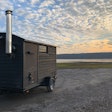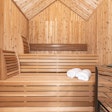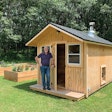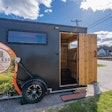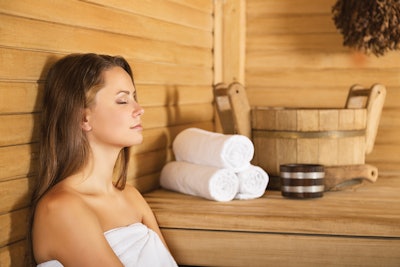
The pandemic changed customer perspectives on all home-based wellness and relaxation products, from swimming pools to spas to workout equipment, and saunas were right there in the mix. With more emphasis on a healthier lifestyle, and an equal focus on activities that bring the family together, saunas saw a concomitant boost in sales.
For some new home sauna customers, it was the simple desire to bring the features of the workout facility home. For this group, in the pandemic age and its aftermath, a small unventilated room — which puts one in very close proximity with strangers — is problematic.
For others, as they built the backyard empires that have marked the last four years, as an integral part of a fully developed wellness lifestyle, saunas just fit right in. Especially in winter, the sauna maintains a big draw to that magnificent outdoor-living haven, which in January features a closed swimming pool and a snowcovered outdoor kitchen.
But for most new sauna converts, given the health and wellness benefits saunas offer, the product is simply a good deal.

HEALTH BENEFITS
Each year, the sauna — once a niche product from northern Europe — becomes more mainstream in North America. And for one simple reason: The sauna's benefits become more widely understood and documented. The physical and mental payoff of regular sauna bathing have become recognized by wellness authorities and even the formal medical community.
Among these known benefits is an increased heart rate, and while a half hour session in the sauna is not the equivalent of a jogging or swimming session, it does offer a mild cardiac workout of some sort. During a sauna session, the heart rate can increase by 50% or more.
Another benefit of saunas is the effect they have on blood vessels. The heat causes blood vessels to expand and therefore increase blood flow, which helps directly in the healing process, enabling the transport of cell-building materials to the injured area.
Saunas are probably the oldest form of detox. Toxins produced in the body are expelled in a variety of ways, but a significant proportion (approximately 30%) have to pass through the skin, as the skin is the body's largest organ. The sweat produced during a sauna session provides ample detoxification for this organ without the effort and expense of special cleansing diets. And it's more fun.
Along with a sweaty detox, the high heat of a sauna raises the body's temperature creating a fever-like state. When you get sick, a fever is the body's way of fighting off the disease. Bringing your body into this state without sickness helps prevent diseases like cold and flu with an increased white blood cell count.

A BREAK IN THE BATTLE
But most users would say that the biggest drivers of sauna growth are the benefits it provides to the mind and soul. It is a product that provides direct stress relief — a major decision driver in the early 20's — and saunas fit that bill perfectly. Nobody can emerge from a long soak in a sauna's ambient heat in a tight ball. A sauna's power to ease mental strain comes in part from its unusual position in the functionality of the home.
There is no other space in the home that serves a single wellness and enlightenment function. It is a room unlike any other, built for a unitary purpose, and that purpose is to raise the level of health and spirit of the user.
That focus is the reason why the sauna escape is so effective — users grow to expect the mental benefits that are always to be found in the small wooden room. And expectation then becomes reality: When the sauna is entered, there is only one goal — departure from the multitasking multiverse that creates the stress of modern life. Even a short break in the battle provides a chance for detachment and evaluation. When the door of a sauna is closed, the world just melts away.

HEAT SOURCE
The practical business of the sauna — heat — is generated in two ways, either through infrared rays or traditional convection, and the choice of technology is determined by the particular taste of the buyer.
For those who enjoy steam in the sauna, higher temperatures or perhaps the idea of hewing more closely the same sauna methods that stretch back literally for millennia, then a traditional sauna will hold more appeal. This type of sauna will often feature rocks that heat up and produce steam when hydrated with a ladle. For the sake of convenience, electricity is the most popular energy source of this type of sauna heat, although wood-burning and gas-burning saunas are available.
Most saunas using electric heat will reach the desired temperature in 40 minutes to an hour. And there are heaters designed to maintain a base temperature of approximately 100 degrees Fahrenheit, which can cut the heat-up time in half. Also, many of the controls available allow homeowners to preset a heat-up time of day to avoid the wait.
For users that prefer lower ambient temperatures and generally lower cost, infrared saunas offer an attractive option. These saunas do not heat the air in the sauna, just the user, so they are ready for use faster than traditional saunas.
This rapid availability of heat can make infrared saunas part of a workout, where the user can switch it on, warm up muscles in the sauna, and upon emerging from the unit, be ready to exercise. Or, as part of the workout recovery process, an infrared sauna can be used to speed up the blood flow and help the healing process.
For those unfamiliar with the physics involved, the use of the term "infrared" juxtaposed with "sauna" can cause confusion and even doubt, but this is groundless. Infrared saunas do use infrared radiation to heat the body. But so do campfires, metal and ceramic steam-fed radiators, and the sun. Literally any warm body, such as a rock or a human, produces infrared rays and transfers heat.
In fact, traditional saunas also create infrared rays that contribute some heat to the user. The difference is that traditional saunas primarily use convection to heat up the room and the user, whereas an infrared sauna primarily uses infrared rays as a heat transfer mechanism to directly warm the user.

THE WORD IS OUT
All of these factors continue to feed the elevated, post-pandemic sales of saunas: the growing body of research that points to direct health benefits, the growing body of anecdotal evidence that points to mental health benefits, and the now-well-established but slightly diminishing surge in consumer support for backyard wellness and leisure products in general.
Retailers expect these trends to continue, and believe the sauna industry has fully emerged as a mainstream product. Consumer education is not as urgent as it once was — the word has gotten out.
This article first appeared in the August 2024 issue of AQUA Magazine — the top resource for retailers, builders and service pros in the pool and spa industry. Subscriptions to the print magazine are free to all industry professionals. Click here to subscribe.
































